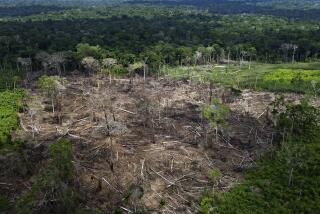The Year of the Greenhouse Effect
- Share via
Suppose we look back over 1988 and ask what the most important scientific advance of the year may have been.
That’s not easy to answer if we confine ourselves to actual discoveries, because the importance of some findings may not be immediately apparent. In 1944, a Canadian-American physician, Oswald Theodore Avery, discovered it was deoxyribonucleic acid , and not protein, that carried genetic information. That was easily the most important discovery of the year and was well worth a Nobel Prize.
At the time, however, scientists weren’t convinced of the importance of the discovery, and by the time it became clear that it had been a turning point in genetics and had led to a revolution in the field, it was too late to honor Avery appropriately. He was dead.
Therefore, as my candidate for the scientific event of the year, let me choose something sociological, something that involves people rather than discoveries. This was the year in which people became aware of something called the “greenhouse effect.”
Adequate temperature records go back only to the 1850s, but 1987 was the warmest year for the Earth as a whole since then, and 1988 will undoubtedly prove to have been warmer still.
Why is this? Because carbon dioxide in the atmosphere acts as a heat trap. Sunlight reaches Earth by day, passing through the atmosphere with little interference, and warming Earth’s surface as a result. At night, the Earth radiates that heat into space, such radiation taking the form of infrared waves. The chief components of Earth’s atmosphere, oxygen and nitrogen, are as permeable to infrared as they are to ordinary light. Carbon dioxide, however, absorbs infrared and reradiates it in all directions. Some returns to the surface and keeps the Earth a little warmer than it would be if there were no carbon dioxide in the atmosphere.
This is a good thing. If there were no carbon dioxide in the atmosphere, the Earth would be in a perpetual ice age. (Also, plants need carbon dioxide for photosynthesis, so that without that gas in the atmosphere, no plants would grow and there would be no life on Earth, except, possibly, bacteria.)
If, however, there were more carbon dioxide in the atmosphere than there actually is, the Earth might get too warm.
The amount of carbon dioxide in the atmosphere before our present Industrial Age began was about .027%. That’s very little but it was enough to keep the plant world growing and to keep the Earth reasonably warm.
However, the amount of carbon dioxide in the atmosphere has been rising steadily. By 1958 carbon dioxide made up .030% of the atmosphere, and by 1988 it was nearly .035%--and still going up. That increase doesn’t seem like much but it’s enough to keep the Earth growing distinctly warmer.
The Earth’s average temperature (evened out for changes of day and night, winter and summer) was about 58 degrees Fahrenheit back in 1880. It is about 59.5 degrees F now. That’s a rise of 1.5 degrees and that, too, doesn’t seem like much. That rise, however, means a lot in terms of longer and warmer heat waves, longer and worse droughts--and, worse yet, rising sea levels.
Partly, the rising sea level stems from the fact that water expands as the temperature goes up. There’s a lot of water in the ocean, and even a 1.5 degree rise expands it quite a bit. Since 1900, the sea level has risen by about 6 inches and it is still going up. Then, too, the warmer temperatures should cause the ice caps in Greenland and Antarctica to begin to melt.
If the ice caps melted completely (which would take awhile, of course) the water formed would empty into the sea, and the sea level would rise by about 200 feet. Places like the Netherlands, Bangladesh, Delaware and Florida would be completely under water.
This warming is not a new discovery that has suddenly been made in 1988. Scientists have thought about the greenhouse effect and been concerned about it for years. Now, because of the heat and drought of 1988, the phrase greenhouse effect has become familiar and people are listening. However, temperatures go up and down irregularly and the next couple of years are liable to be a little cooler than 1988 even though the general trend is upward. If this happens, I imagine that people will forget again, until a year comes in the near future that is even worse than 1988.
But what can we do about the problem? To begin with, we must cut down on the burning of coal and oil. Such burning constantly pours carbon dioxide into the atmosphere (along with pollutants such as sulfur and nitrogen compounds that also act as heat traps, and that are dangerous to the lungs as well).
Natural gas, when burned, produces less carbon dioxide than coal and oil do, and hydrogen, when used as a fuel, produces no carbon dioxide at all. Even nuclear energy is to be preferred to coal and oil, in my opinion. Nuclear energy has its dangers, but with a great deal of care it might be made safe and the radioactive wastes might be disposed of safely, too. There is, on the other hand, no way of making the burning of coal and oil safe.
The best source of energy, of course, would be solar energy. Light and heat from the sun reaches Earth anyway, and if we use that heat before it is absorbed by Earth’s surface, that would in no way increase the heat content of Earth or change the atmosphere.
Working from the other end, how can we remove the carbon dioxide once it is in the atmosphere? The best way is to encourage the growth of forests. Trees absorb carbon dioxide and produce the all-essential gas oxygen more efficiently than any other form of vegetation.
And yet far from doing this, we are doing the opposite. The forests of the Earth are being chopped down at a huge rate, especially in tropical countries such as Brazil. This must be stopped. It is suicidal to maintain that what a country does within its own borders is its own business. The loss of the forests will increase the carbon dioxide supply and decrease the oxygen supply for all humanity. This is an example of the global nature of the dangers that oppress us, and proves that no nation can be allowed to be a law unto itself. Solutions must be global, too.






